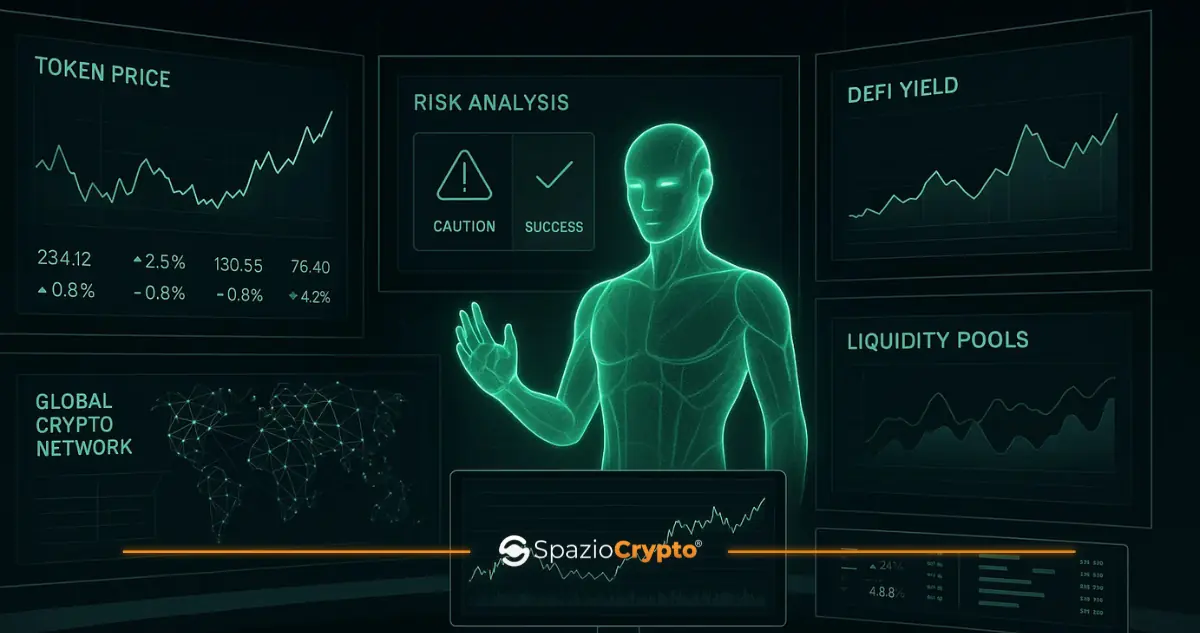In the vast and complicated world of cryptocurrencies, the search for clarity and understanding is a constant challenge. Amidst a mysterious list of terms such as crypto, token, stablecoin, utility token and security token, navigating can seem like a difficult and inaccessible journey. SpazioCrypto aims to shed light on this tangled jungle of definitions, offering a comprehensive and clear guide to the types of cryptocurrencies and tokens that populate the digital financial system, and an overview of all the details of the advent of Web3. Regulators such as the SEC, FINMA and the IRS are trying to understand and regulate this new financial universe, but a definitive legal framework is still lacking at the moment.
Cryptocurrency categories
In our journey through the world of Web3, we now examine the different types of cryptocurrencies. These form the core of digital currencies, each with its own unique characteristics and distinct purpose.
Bitcoin
Bitcoin is the pioneer of cryptocurrencies, born in 2009 as a bold idea to create a decentralised digital currency system. This cryptocurrency is known to be a digital store of value and a medium of exchange. Its blockchain technology, based on cryptography, has set new standards of security and transparency. Bitcoin continues to influence the entire cryptocurrency industry and the global financial system, and is often a benchmark for other digital currencies. It is probably the only cryptocurrency that can currently be considered as a potential long-term store of value.
Altcoins
Altcoins constitute a wide variety of cryptocurrencies other than Bitcoin, each with their own unique characteristics. These digital currencies have emerged to meet specific needs or to bring about technological innovations. For example, Ethereum introduced smart contracts, while Litecoin focuses on faster transactions. Each altcoin has a distinct purpose and a community of supporters. By exploring altcoins, we will discover how they have expanded the possibilities of the cryptocurrency ecosystem.
Meme Coins
Meme coins represent a peculiar category of cryptocurrencies, often created for entertainment purposes and viral phenomena. These digital currencies draw on popular culture and online humour to gain notoriety. For example, Dogecoin became famous thanks to the Shiba Inu dog meme. Although they may seem frivolous, some meme coins have attracted an enthusiastic following and have demonstrated a lasting impact.
Utility Tokens and Asset Tokens
We will now delve into two basic categories: utility tokens and asset tokens. These types of cryptocurrencies play key roles in the Web3 ecosystem, enabling a wide range of blockchain-based applications and services. We will look at the definitions and nuances of both types of tokens, exploring how they contribute to the diversification of possibilities offered by cryptocurrencies.
Utility Tokens
Utility tokens are a key pillar in the cryptocurrency ecosystem, being crucial for a wide range of applications and services. These tokens are designed to perform a specific function within a blockchain or decentralised application. Their creation usually takes place through initial coin offerings (ICO), which involve the distribution of these tokens to investors in exchange for funding.
What makes utility tokens unique is their ability to act as virtual keys to unlock functionality or services within the ecosystem. For example, within a blockchain gaming platform, a token could allow players to access special items or unlock advanced levels. In a decentralised social network, the token could be used as a means of payment for premium services or to incentivise user engagement.
The versatility of utility tokens makes them a significant innovation within cryptocurrencies, allowing platforms to create internal economies and engage the community directly. However, it is important to note that regulation and security are crucial issues when it comes to utility tokens, as their distribution can be subject to local and international regulations.
Asset Tokens
Asset tokens represent a revolutionary change in the management and fractionation of asset ownership, which can be either tangible or intangible. These tokens are anchored to a specific real-world asset and serve as digital proof of ownership. Their registration on blockchain provides unprecedented traceability and transparency in asset management.
A concrete example of asset tokens is the tokenisation of a part of a commercial building. In this case, the tokens represent the investors' ownership share, allowing them to own a fraction of the building. This subdivision of ownership is possible thanks to tokens, which can be bought, sold and traded efficiently on the blockchain.
The use of asset tokens can revolutionise numerous sectors, from real estate finance to art. The tokenization allows for the liquidity of previously illiquid assets, making it possible for investors to acquire a portion of expensive assets such as artwork or real estate. However, as in the case of utility tokens, regulation is a critical aspect, as asset tokens can involve complex financial regulations.
In summary, asset tokens represent a major step forward in the democratisation of asset access and management, while utility tokens provide the foundations for new blockchain-based internal economies. Both play a crucial role in the evolution of the cryptocurrency ecosystem and in changing the way we manage ownership and access to digital services.
Equity Token and Security Token: Revolution in Digital Finance
We will take an in-depth look at two categories of tokens that have disrupted the world of digital finance: equity tokens and security tokens. These digital financial instruments represent a significant step in the evolution of cryptocurrencies and investment opportunities.
Equity Tokens
Equity tokens represent a piece of ownership of a company or economic entity, similar to traditional shares. However, the fundamental difference lies in the use of blockchain to register and manage this ownership. Owning equity tokens means owning a programmable and trackable share of ownership on a blockchain. These tokens allow corporate ownership to be broken down into a series of smaller fractions, making investment more accessible and transparent.
A key aspect of equity tokens is that they represent a step forward in the democratisation of investment. Investors can now participate in entrepreneurial projects, startups or businesses of their interest without having to deal with traditional financial intermediaries. In addition, the programmability of equity tokens makes it possible to automate distributions of dividends, voting rights and more, improving the efficiency of business operations.
Security Token
Security tokens represent a class of digital assets that fall under the scope of financial security laws. These tokens provide holders with rights to profit sharing, company ownership or other investment-related aspects. Their legal definition often follows the "Howey's test", which states that a financial product is considered a security if it implies that a consumer invests money in a joint venture with the expectation of profit derived primarily from the efforts of others.
The cryptocurrency world is gradually evolving in the direction of security tokens and security token offerings (STOs), which represent a method of raising funds in line with existing financial regulations. A distinctive aspect of security tokens is that they bring greater security and regulation to the world of cryptocurrencies, attracting institutional investors and improving user confidence.
Stablecoins: The Stability in Crypto Volatility
We will explore a special category of cryptocurrencies called "stablecoins". These digital assets are designed to minimise price volatility, offering a stability that is often lacking in other cryptocurrencies such as Bitcoin and Ethereum.
Stablecoins: An Introduction
Traditional cryptocurrencies, such as Bitcoin, are known for their extreme price fluctuations. This makes it difficult to use them as reliable forms of payment or store of value. That's where stablecoins come in. These tokens are designed to maintain a stable value by pegging it to a pool of traditional assets or currencies.
Use of Stablecoins
Stablecoins have a number of practical uses in the cryptocurrency ecosystem:
Value Preservation: Investors use stablecoins to protect the value of their crypto assets during periods of market volatility. When they feel the market is about to go down, they can convert their assets into stablecoins to avoid losses.
Exchange and Trading: Stablecoins are widely used as trading pairs in cryptocurrency exchange platforms. They allow traders to quickly move in and out of positions without having to return to traditional currencies.
Digital Payments: Because of their stability, stablecoins are ideal for everyday transactions. Online merchants and service providers often accept them as a payment method.
Decentralised Finance (DeFi): Stablecoins are a key component in the DeFi ecosystem. They are used as collateral to take out loans, earn interest or participate in liquidity pools.
The Future of Tokens and Cryptocurrencies
With a wide range of digital assets available to investors and users, knowledge of these categories is essential to make informed decisions and make the most of the opportunities offered by blockchain technology.
Diversity and Specialisation
As we have seen throughout this article, the cryptocurrency world is extremely diverse, with each token category playing a specific role within the ecosystem. While Bitcoin remains the most recognisable and suitable cryptocurrency as a store of value, other types of cryptocurrencies and tokens have evolved to meet more specific needs.
The Importance of Diversification
For investors, diversifying one's cryptocurrency portfolio can help mitigate the risks associated with market volatility. For example, while utility tokens can offer revenue opportunities through use in blockchain applications, stablecoins can be used to protect the value of investments during periods of market declines.
Innovation and Opportunity
The blockchain ecosystem continues to evolve, with new token categories and applications constantly emerging. Investors and cryptocurrency enthusiasts should stay informed about the latest trends and innovations, as this can lead to new investment opportunities and the creation of innovative solutions.
The Need for Cautious Evaluation
While cryptocurrencies offer many opportunities, it is critical to carefully examine each token category and conduct a thorough evaluation before investing in or using these assets. Fraud and Ponzi schemes are unfortunately common in the crypto ecosystem, so education and awareness are key.
Final Considerations
In the end, the cryptocurrency ecosystem is a world full of opportunities and challenges. The different types of cryptocurrencies and tokens we have analysed in this SpazioCrypto educational article represent a variety of digital assets, each with a specific role. Understanding these categories and their applications is a crucial step to participate in an informed and responsible way in the evolution of blockchain technology. We hope this article has provided you with a comprehensive overview of the types of tokens and cryptocurrencies that exist, enabling you to further explore this fascinating world and make informed decisions on your path to the Web3.








